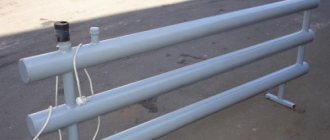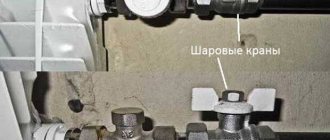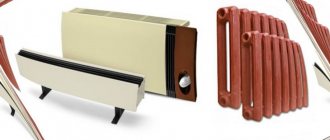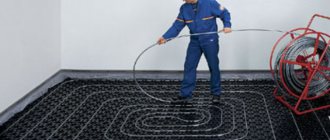In the countries of the former Soviet Union you can find many city houses where the heating radiator is built inside the wall. Such houses, for example, are available in Russia (Moscow, Chelyabinsk, St. Petersburg), Ukraine and Belarus. But how should we treat such built-in radiators now? Should this experiment of Soviet builders be considered a failed stupidity? Or was it a successful experiment that did not continue? Moreover, what to do with such a heating battery: replace it or leave it as is? Let's try to figure it out.
In-wall radiator discovered during wall dismantling
Why did they suddenly start installing heating radiators inside walls?
Such houses were built, as a rule, during the Khrushchev and Brezhnev eras. Moreover, the main task facing the architects and builders was to quickly provide people with their own housing. Therefore, in principle, the formation of a heating system directly when pouring reinforced concrete structures was quite logical.
Moreover, in-wall radiators truly represent an innovative and practical solution. As a result of using this technique, the reinforced concrete slabs themselves are heated. And not the air outside, as many people think. But this is only provided that:
- firstly, reinforced concrete was manufactured without technological violations;
- secondly, high-quality insulation is installed in the slabs.
If these conditions are met, the heat is directed inside the apartments. And as a result, significantly less energy is required to heat them effectively. Moreover, the air humidity in the rooms is less than when installing conventional wall-mounted heating radiators. For this reason, this technology is now increasingly used in European countries.
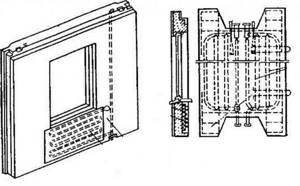
Approximate layout of an in-wall heating system
During the Soviet era, in-wall installation of radiators became quite widespread. Moreover, the designers sought to improve this technique in every possible way. As a result, quite a few modifications of in-wall heating arose:
- sometimes only risers were laid in the slabs;
- once upon a time all the elements of the heating system were installed in them;
- in accordance with some projects, heating pipes were located in the facade walls;
- other projects involved their installation only in interior walls.
How to recess heating pipes into the wall
Many people believe that recessing pipes into the wall is too dangerous. But if everything is done correctly, problems can be avoided.
Use only high-quality and durable materials, and do not trust installation to just anyone. If the main is located inside a wall, it is not so easy to get to.
All materials tend to expand and contract with temperature fluctuations. Therefore, heating pipes cannot be cemented or covered with plaster - they will quickly wear out, and joints and connections will break.
Pipes must be covered with high-quality thermal insulation to avoid heat loss. It is preferable to use materials with a top heat-reflecting screen made of metal foil.
It is best to cover the gate with plasterboard so that, if necessary, you can easily reach the highway.

A groove of this size will fit a thermally insulated pipe and will leave enough space for covering it with plasterboard.
What troubles can arise if the radiator is located inside the wall?
As a rule, the main problem with such batteries is the inability to turn them off if it gets hot. But at the same time, we must not forget about the aging of houses and pipes installed in slabs. That is, a breakthrough can be expected at almost any time.
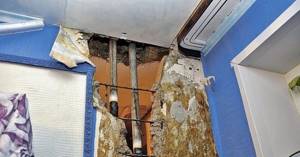
These risers are located inside slabs with in-wall heating
If the pipes are not walled up, then the accident can be eliminated quite simply. If the pipes are inside the slabs, then this matter will turn out to be quite complicated.
Centralized heating scheme for Khrushchev

The houses of this project are characterized by a single-pipe scheme, when the distribution of coolant starts from the top (5th) floor and ends with the entry of cooled water into the basement. Such heating systems in Khrushchev have one significant drawback - uneven distribution of heat throughout the apartments.
This is due to the alternate passage of the coolant through the floors, i.e. The greatest degree of its heating will be on the 5th, 4th, and on the 1st the amount of heat is not enough to heat the room. In addition, the heating scheme of a five-story Khrushchev building has the following disadvantages:
- Poor condition of heating elements. Lime build-up on the inner surface of pipes and batteries leads to a decrease in diameter, and as a result, a decrease in heat transfer;
- Lack of temperature control system on batteries. Reducing the flow of coolant using devices is impossible, as this will affect the hydraulic pressure in the entire system. The solution is to install a bypass on each radiator.
To solve these problems, it is necessary to carry out modernization - install modern radiators and pipes. Metal heating devices and pipelines made of polymers have proven themselves to be the best. They have increased heat transfer rates, which helps to heat rooms faster. However, to create a truly effective heating system in a Khrushchev-era building, it is necessary to replace all floors. If old pipes and radiators are left on the top ones, then the speed of water passage in the system will remain unsatisfactory.
Such modernization can be carried out not only by residents, but also by attracting the resources of the housing office. This organization is obliged to carry out planned replacement of pipelines. They know how the heating system in a Khrushchev building works - the diagram and location of pipelines for a particular house.
What you need to remember when deciding to remodel your in-wall heating system
Options for the location of the in-wall heating system may be different. But in any case, you must understand that your actions with the riser will affect the apartments of the entire entrance. That is, the quality of your neighbors’ heating will change. If you do take on this work, then you should not narrow the riser or block it.
Moreover, you will actually act by touch. Because you won’t be able to determine all the design features of the house on your own. As a result, this fact may result in some surprises and even troubles for you.
How to insulate an apartment yourself
A panel house is obviously colder than a brick house.

- The whole house is warm , only a few apartments are cold . Is it possible to insulate only them from the outside , and not wait for major repairs or thermal modernization ?
This happens due to defects in individual panels of the house. Based on citizens’ requests and subsequent inspection of the apartment by representatives of the housing service and design organization, the apartment can be insulated. Insulation is provided free of charge. If a person wants to insulate the slabs of his apartment on his own, one square meter will cost him 80 thousand rubles.
- How effective are individual heat metering devices ? Can they be installed in old houses ?
Since 2003, heating systems with individual heat energy metering have been installed in new residential buildings. If you follow the guidelines, during the heating season, depending on the size of the apartment, you can save up to 200 thousand rubles on heating.
It is impossible to install individual heat meters on the existing heating system of a house without its reconstruction. But neither during major repairs nor during thermal modernization of houses does the heating system need to be reconstructed.
- It's cold in a panel house ; it needs to be insulated . They say it's a queue . Is it possible to wedge into it instead of waiting several years ?
Thermal retrofitting of a home depends on many factors: financing, plans, etc. sequence. That is, those houses whose residents submitted an application earlier will be the first to be modernized. At the same time, these issues should not drag on for years.
- Is it possible to remove the battery from the wall of a panel house ?
The removal of batteries relates to the redevelopment and redevelopment of apartments, and therefore is regulated by the Regulations on the procedure for the redevelopment and redevelopment of residential premises in multi-apartment residential buildings. Such work must be carried out with the permission of the district administration according to the agreed project. The exact procedure can be found in the “One Window” service of the administration or in the housing and communal services department. The main stages of reconstruction of the heating system are as follows: finding a design organization, developing a project and its approval, concluding an agreement with technical supervision, an organization that will carry out these repair work. The removal of batteries ends with the acceptance of work by the housing organization.
During the heating season, no one will be involved in removing the batteries. But you can start preparing today. Despite the fact that all the work can be completed in a couple of days, project development and approval can take several months.
Officially
“Currently, almost all residential buildings with 20 or more apartments are equipped with group heat energy metering devices and automatic control systems,” says Deputy Minister of Housing and Communal Services Nikolai LIPEN . – This allows you to automatically maintain the required temperature in living quarters – from 18 to 24 degrees. In case of deviation from these requirements, every citizen has the right to contact housing organizations, which must inspect and take measures to adjust and regulate, to ensure the temperature regime both in a residential building and in a separate apartment.
According to Deputy Minister of Housing and Communal Services Nikolai Lipen, misunderstandings should not arise between residents of the house and housing department employees:
“It is the responsibility of the housing organization that maintains the house to provide housing and communal services and take measures to normalize the situation. What measures are another question. At a minimum, each apartment must maintain a minimum temperature. The parties must find a common language. If they don’t find it, then today the Law “On the Protection of the Rights of Consumers of Housing and Communal Services” is in force. A citizen can call on an independent commission, and if high-quality housing and communal services are not provided, then the service is either not paid for at all or not paid in part.
Tips for self-preparing for winter from the Ochag owners’ association:
- Radiators must be clean both outside and inside. Over many years of operation, they are so clogged that water cannot seep through, no matter how warm it is. Radiators need to be flushed.
- Covering heating appliances with decorative slabs, panels and even curtains reduces heat transfer by 10-12%. Painting radiators with oil paints reduces heat transfer by 8-13%, and with zinc white increases heat transfer by 2.5%.
- First, windows and doors should be insulated (or better yet, replaced), since the main heat loss occurs through them. Next, insulate the outer walls, if the room is corner, and the walls facing the staircases. It is useful to cover the wall behind the heating radiator with heat-reflecting materials.
- Before insulating windows for the winter, you should thoroughly wash the glass. In general, this should be done more often, as it helps save energy on lighting.
- For the winter, wooden window frames can be covered with paper. This should be done from the inside and in calm weather. Paper glued with milk (can be sour) holds well.
- However, it is better to use special sealing materials. There are a lot of them on sale, and some can work for several years. They are also successfully used to insulate the now fashionable metal doors.
- If your window glass is cracked, you can cover the crack with clear nail polish as a temporary solution.
- Installing low-e thermal reflective film on window glass reduces heat loss through windows by 35-45%.
- Glazing of balconies and loggias can reduce overall heat loss by 10-13%. Double entrance doors will also help conserve heat in the house.
- It is better to keep the refrigerator full at all times. The high heat capacity of the stored products will maintain an even temperature in it, and the compressor will turn on much less often. And during a power outage, this can save food from thawing. But it is unacceptable to place hot saucepans there.
Transferring the battery to the loggia in a legal way
Removing the radiator onto the balcony falls under the category of apartment redevelopment, which means that in order to legally move the heating device, the apartment owner needs to develop a project, the result of which should be a change in the status of the loggia.
To legally remove the battery, the loggia from a non-residential premises must be turned into a living room. Only under such conditions can the owner of the living space count on approval of the transfer procedure.
Before figuring out how to legalize the transfer of the battery to the loggia, you need to stock up on strength and patience, because this is a very complex bureaucratic procedure. Let's look at the step-by-step process of legalizing moving a battery to a loggia/balcony:
Contacting the BTI
Since moving the battery is a redevelopment, the owner needs to contact the BTI so that a specialist can draw up a new apartment plan.
To do this, the owner must present the title documents for the apartment, a passport, as well as the current apartment plan.
The cost of drawing up a plan varies between 8-15 thousand rubles, but for accelerated preparation you will have to pay how much extra.
Contacting the design office
With a new apartment plan, the owner should go to the design office, where the designer will draw up a redevelopment plan, taking into account the current state of the heating devices, the loggia itself, etc.
The specialist must go to the site, carry out an inspection, listen to the customer’s wishes, but make a decision in accordance with the law and established requirements for the operation of residential premises.
It takes an average of 2 weeks to develop a new apartment redevelopment project, and the cost of designer services starts from 5 thousand rubles (depending on the region, the size of the apartment, the features and difficulties of the redevelopment).
Obtaining permission from the relevant authorities
When the redevelopment project is ready, the owner needs to obtain permission to remove the battery from several authorities:
Let's sum it up
To transfer radiators to the loggia, you must obtain permission from the relevant authorities. This may take quite a long time. Therefore, in most cases it makes sense to consider other options: warm floors, ceiling infrared heating. Such systems are no less effective, and installation does not require approvals.

Sources
- https://tgorlovka.com/2020/07/30/mozhno-li-samostoyatelno-i-bez-soglasovaniya-perenosit-batarei-v-kvartire/
- https://fanera-info.ru/sovety-dlya-doma/nuzhno-li-razreshenie-na-perenos-batarey
- https://VseOBalkonah.ru/lodzhiya/perenos-batarei-na-lodzhiyu.html
- https://okna-dom.net/pernos-batarei-na-lodjiyu/
- https://GSPS.ru/nuzhno-li-soglasovyvat-perenos-batarei.php
- https://apb1.ru/nuzhno-li-soglasovyvat-perenos-batarei.html
- https://zonabalkona.ru/remont-otdelka/batarei-na-balkone.html
- https://TeploRes.ru/montazh-i-remont/kak-vyvesti-batareyu-na-lodzhiyu.html
How do you like the article?

Sergey Vladimirovich
Ask a Question
Choosing a radiator
When the procedure for obtaining permission has been successfully completed, it is time to choose a room heating element that is suitable for the loggia.
All batteries are divided into 3 types:
- economy segment;
- middle class;
- premium
The main criteria for differences are cost, quality of materials and duration of operation.
Cast iron
The best and most durable metal of all times has been and remains cast iron. The shelf life of such radiators is more than 35 years. They are stronger than analogs made from other materials, but they weigh a lot. It is recommended to install it on the loggia only from the side of the house wall. The balcony can support no more than 600 kg of weight.

There is no need to additionally load it, because there is an installed double-glazed window, finishing, tiles on the floor (or other covering), and furniture. They look quite massive and the classic look does not always fit into a modern interior.
We recommend: Causes of clogged sewer pipes
Aluminum
They weigh much less, are made in a modern design, and conduct heat well. The only negative: they can rust and deteriorate if the water they receive is of poor quality. Recommended for private homes where the source of water is known and autonomous.
Bimetal
Radiators of this type are most often used in apartment buildings. Bimetallic structures are compact and look laconic. They come in different sizes, conduct and release heat well. Ideal for a balcony or loggia due to its light weight and versatility in installation.
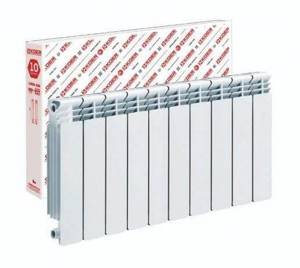
Is it possible to move the battery in the kitchen or room?
The correct decision when replacing a heating radiator is to select a new device with similar thermal characteristics. By observing this condition, you can move radiators in your apartment without fear that problems will arise for you or your neighbors during the heating season.
In addition, one of the conditions that you need to remember during repairs is to preserve access to the heating risers - if you plan to cover them with decorative boxes, they should be made easily removable (for example, fastened with magnets).
An example of a redevelopment project with battery relocation:
In the example given, the heating battery was removed from the partition between the kitchen (4) and the room (3), since this partition was demolished during the redevelopment. A floor-mounted convector of similar power was chosen as a heating device.
The location of heating devices is indicated in the technical report, and in the redevelopment project all construction measures and technologies used are described in detail, including the item on moving or replacing the heating battery.
Preparation for installation
Preparatory activities include several mandatory steps.
Radiator selection
You need to choose the type of radiator based on its technical characteristics , the most important of which is operating pressure. It must comply with the pressure drop limits in the heating system of the house. As a rule, in old five-story buildings the value of this indicator is 6–8 atmospheres, and in multi-story buildings (10–14 floors) the pressure level reaches 12–15 atmospheres.
The second important indicator is resistance to water hammer . The service life of the radiator and the quality of heating depend on this characteristic. With a centralized heating system, it is almost impossible to avoid water hammer, so when choosing equipment you need to pay attention to this technical characteristic. Additional important factors include lifespan, ease of installation, and heatsink design.
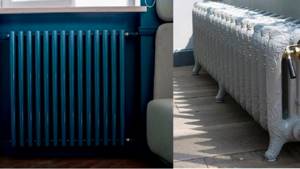
Types of radiators
Types of batteries and radiators are divided according to classes and materials of manufacture:
- Cast iron. They have the longest service life (up to 35 years). The main disadvantage is the long heating and cooling time.
- Steel panel. They will last about 15 years. They are valued for their high heat transfer rates and other technical characteristics, as well as their low cost.
- Tubular steel. They are available in a variety of colors and designs, allowing you to match them to any interior. They have excellent consumer properties. The disadvantages include high cost.
- Aluminum. Average service life is 15 – 20 years. They are characterized by high thermal conductivity and low weight. The main disadvantage is the sensitivity of the filler to the PH, therefore they are recommended for private houses with an autonomous heating system.
- Bimetallic. The best option for an apartment, as they are unpretentious in terms of the composition and quality of water, have good heat transfer, and are resistant to water hammer.
We recommend: Sources of water supply: artesian well
Calculation of the number of sections
All types of radiators are composite, so you can select the number of sections needed to heat a particular room, depending on the area.
The calculation must be made on the basis of generally accepted standards:
- one aluminum section per 2 m2;
- one bimetallic section per 1.5 m2;
- add 1-2 sections for reinsurance.
Selecting a connection option
You can consider the following connection methods:
- Side. The most common installation method. The inlet and outlet pipes are mounted on one side of the radiator. The main requirement is to maintain the distance between the fittings, otherwise the radiator will not warm up sufficiently.
- Lower. With this option, both pipes are mounted at the bottom of the radiator - inlet on one side, outlet on the other. The main disadvantage is low heat transfer.
- Diagonal. The input is mounted on top on one side of the radiator, and the output is mounted on the bottom on the other. With this method, the least heat loss is achieved, so it is considered the best.
Which pipes to choose
For work , it is recommended to choose reinforced polypropylene pipes because they :
- easy to bend, allowing installation of any complexity;
- do not deform during operation;
- do not require welding - flux is applied to the joints and sealed with a special blowtorch;
- have a high heat transfer coefficient.
It is possible to use copper pipes, but this is a more expensive and difficult to install option. Ordinary propylene quickly deforms and loses its attractive appearance.

